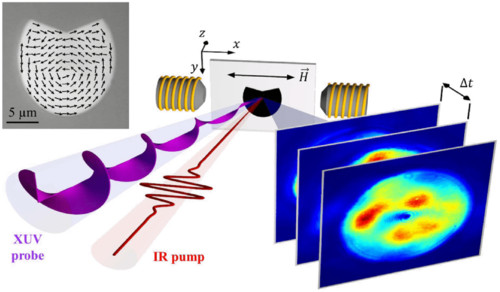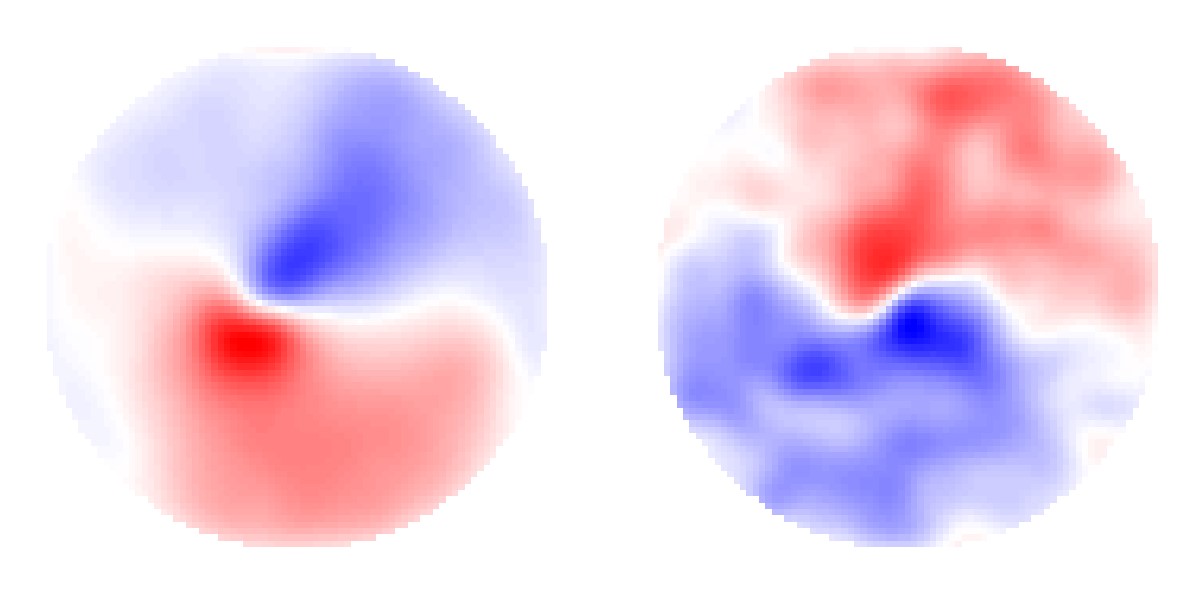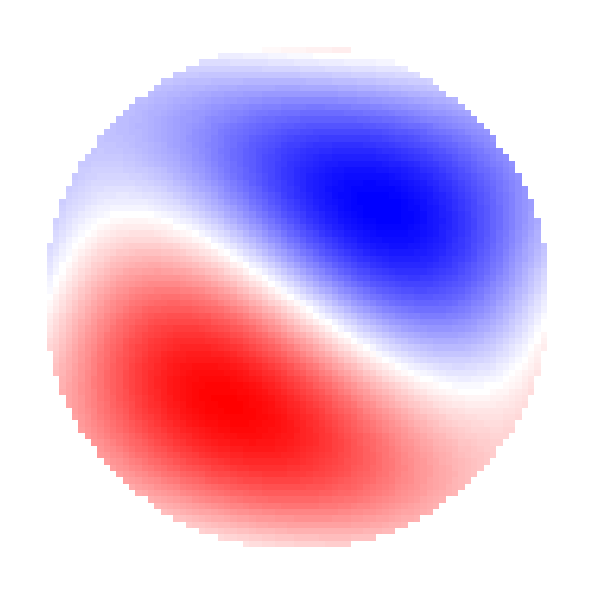Micro- and nanostructures of magnetic materials are the basis for a wide range of technological applications, from sensors to data storage. New methods for measuring and controlling the dynamics of their magnetization are therefore worthy of research. A widely-used technique for measuring magnetization is magnetic circular dichroism (MCD), i.e. the measurement of the difference in response of a magnetic system subjected to a right- or left-hand circularly polarized light beam.
A broad international collaboration, including a joint team from LIDYL and Université Cergy-Paris, has shown that it is possible to obtain picosecond-scale time-resolved magnetic helicoidal dichroism measurements with light pulses carrying an orbital angular momentum ℓ (helical wave plane). This new method is particularly useful for monitoring the magnetization dynamics of magnetic vortices.
The response of matter to a laser pulse is a function of its polarization (i.e. the orientation of the wave’s electric field), most often linear or circular (right or left), or more generally elliptical. Note that, according to the quantum interpretation of light as a photon, circular polarization corresponds to spin angular momentum. Another chiral quantity exists, the orbital angular momentum (OAM), which corresponds to a light beam structure whose wave plane takes on a helical shape.
In 2021, the Lidyl team presented an electromagnetic theory of magnetic helicoidal dichroism (MHD) on magnetic structures, associated with orbital angular momentum ℓ (OAM). This theory was rapidly confirmed by an experimental proof-of-concept in 2022, with the observation of this type of dichroism depending on the direction of rotation of the magnetization of a magnetic vortex structure, on the scattering profile of an ultraviolet (XUV) light beam carrying an OAM.
Today, an European collaboration involving the same LIDYL-CY team shows that it is possible to perform a time-resolved MHD experiment on the FERMI free-electron laser in Trieste, Italy. Indeed, it has been possible to film the picosecond-scale temporal evolution of the response of a magnetic vortex, after the excitation by a femtosecond ultrafast infrared laser pulse.

Experimental setup: A femtosecond infrared pulse provides an initial excitation of the magnetization of a micrometer-diameter magnetic vortex, carried by a permalloy dot (diameter 15 µm, height 80 nm) deposited on a Si wafer. After a well-controlled delay of a few picoseconds, an XUV laser pulse carrying an orbital angular momentum ℓ (MAO, helical wave plane) probes the system. Magnetic field pulses are used to reverse the direction of rotation of the vortex magnetization. For the very same delay, the difference in light scattering signal for right and left-hand magnetic orientation provides the magnetic helicoidal dichroism (MHD) signal, enabling to follow the dynamics of the magnetization.
While it is known that a magnetic material excited by an ultrafast infrared laser pulse temporarily loses its magnetization, due to an energy redistribution between spin, charge carriers and phonons, the phenomenon remains poorly understood at atomic and microscopic levels. It is indeed very difficult to follow the magnetization distribution in detail during this transient period. The time-resolved DMH technique has made this type of observation possible by following step-by-step the changes in the magnetization structure of a micrometric magnetic vortex during this transient phase of demagnetization – re-magnetization. A complex behavior is observed, varying within the thickness of the vortex, and even involving a temporary reversal of the magnetization direction at the vortex surface.

The same XUV – OAM light scattering measurement, for two directions of rotation of a magnetic vortex, provides a magnetic helicoidal dichroism (red +, blue -) with a probe laser impulsion carrying an OAM ℓ=1. Left: initial measurement at the moment of magnetic excitation of the system by the 60 fs infrared pulse. Right: observation of a temporary inversion of the dichroism signal after a 20 picoseconds delay.

Movie of the evolution of the MHD signal as a function of pump-probe delay (from -3.5 to 100 ps, 20 images) with a probe beam carrying the OAM ℓ=1, and a pump fluence of 4.5 mJ/cm2.
This result, published in Physical Review Letters, is the fruit of a wide-ranging international collaboration* involving scientists from the Lidyl/atto-CY team at CEA Saclay. This work highlights the potential of time-resolved MHD as a new technique for characterizing magnetic properties in micro- and nanostructures. It has allowed to follow with more details the evolution of a magnetic structure perturbed by a short IR laser pulse, which is an important result for a better understanding of the writing and processing of magnetically encoded information.
Reference :
Magnetic vortex dynamics probed by time-resolved magnetic helicoidal dichroism
M. Fanciulli, M. Pancaldi, A.-E. Stanciu, M. Guer, E. Pedersoli, D. De Angelis, P. R. Ribič, D. Bresteau, M. Luttmann, P. Carrara, A. Ravindran, B. Rösner, C. David, C. Spezzani, M. Manfredda, R. Sousa, L. Vila, I. L. Prejbeanu, L. D. Buda-Prejbeanu, B. Dieny, G. De Ninno, F. Capotondi, T. Ruchon, and M. Sacchi, Phys. Rev. Lett. 134 (2025) 156701.
See also the highlight and related references: “Première observation du dichroïsme hélicoïdal magnétique sur les structures de type vortex” (Lidyl/Atto).
Contact CEA and CYU : Mauro Fanciulli, Lidyl/DICO et LPMS, Cergis-Paris Université (CYU).
*Collaboration :
- CY Cergy Paris Université, CEA, LIDYL/Atto, 91191 Gif-sur-Yvette, France
- Université Paris-Saclay, CEA, LIDYL/Atto, 91191 Gif-sur-Yvette, France
- New Technologies Research Center, University of West Bohemia, 30100 Plzeň, Czech Republic
- Elettra-Sincrotrone Trieste S.C.p.A., 34149 Basovizza, Trieste, Italy
- Department of Molecular Sciences and Nanosystems, Ca’ Foscari University of Venice, 30172 Venezia, Italy
- Université Grenoble Alpes, CNRS, CEA, Grenoble INP, IRIG-SPINTEC, 38000 Grenoble, France
- Sorbonne Université, CNRS, Institut des NanoSciences de Paris, INSP, 75005 Paris, France
- Laboratory of Quantum Optics, University of Nova Gorica, 5001 Nova Gorica, Slovenia
- PSI Center for Photon Science, Paul Scherrer Institute, 5232 Villigen PSI, Switzerland
- Synchrotron SOLEIL, L’Orme des Merisiers, Saint-Aubin, B. P. 48, 91192 Gif-sur-Yvette, France


